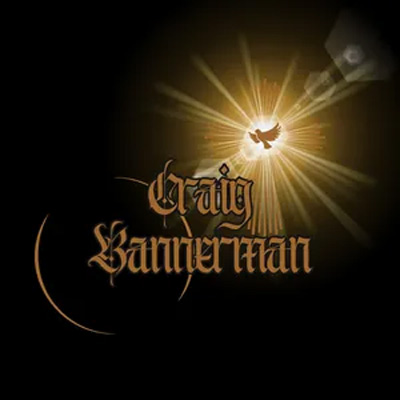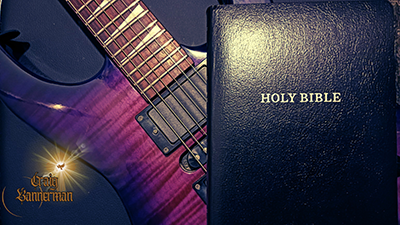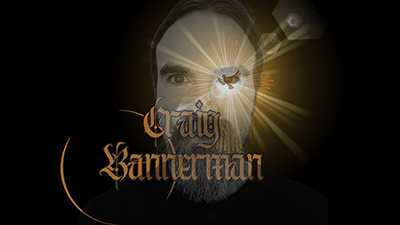Sometimes a song is born out of the depths—where body and soul wrestle, and faith is shaped not in comfort, but in the fire of loss, illness, and desperate hope. “I Am the Resurrection and the Life” is not another track in the crowded field of extreme metal. It is, as the author says, a cry forged from weakness, a hymn burned in the shadow of trauma and spiritual warfare, and a bold proclamation that even the darkest genres can be redeemed for the glory of Christ. In this article, we look at the prayerful impulse that birthed this composition, the collision of extreme aesthetics with the pure Gospel, and the path of an artist standing at the intersection of underground metal culture and timeless faith.
 What was the prayerful/spiritual spark that led to “I Am the Resurrection and the Life”?
What was the prayerful/spiritual spark that led to “I Am the Resurrection and the Life”?
I was coming out of the flu and could barely breathe (you may recognise one scene in the music video); my body kept cycling between panic and exhaustion for many hours. Having lived a life of significant trauma, loss, mourning, grief, godly consequence, and sorrow, my desire was to depart and be with Christ - for He is my joy. There is nothing in this world I truly desire, nothing I hold on to. I have been crucified with Christ, and the life I now live, I live for Him.
But in the sickness I noticed something very clear: the tension between the old man and the new man. When confronted with the shadow of death, the new man - who has died to self and lives in Christ - desired only to depart and be with Him, and was unafraid. Yet the old man clung to life, panicking and fearing death. In that weakness, I could sense the old man’s fear, but I also knew with certainty that it was not me. The new man was above it, full of peace. That “cloudy tension” became the seed of this song.
When the body began to heal, spiritually I felt the return of life - a shadow of resurrection. Out of that place, the Lord pressed John 11:25-26 upon me:
“I am the resurrection, and the life: he that believeth in me, though he were dead, yet shall he live:
And whosoever liveth and believeth in me shall never die. Believest thou this?”
This verse is not only a promise of resurrection but also a summons to live in Him. Whosoever liveth means a life of obedience born of love. That’s why the song also became a reminder of His question to us: “Do you love Me?” And even further, a question He once gave me personally: “Do you love Me enough to die for Me?”
As Peter was told:
“Most assuredly, I say to you, when you were younger, you girded yourself and walked where you wished; but when you are old, you will stretch out your hands, and another will gird you and carry you where you do not wish.” (John 21:18)
In summary, this song is both a reminder of His promise and an invitation to that same self-denial: to pick up your cross, to die to yourself, even to let go of your body for the One you love. Do you love Him? Or do you love yourself more than Him?
Finally, the song also stands as a direct confrontation with the pride of life and the flesh - the declaration of Hebrews 9:27, “it is appointed for men to die once, but after this the judgment,” and Romans 6:23, “for the wages of sin is death; but the gift of God is eternal life in Christ Jesus our Lord.”
The track moves from images of death and despair into a victorious proclamation of Scripture. Was that two-act arc intentional from the start?
Everything came together when I recorded the end riff - which I call the “resurrection riff.” It uplifted the entire first half and birthed the vision for the song. Nothing sounds oppressive in its infancy; I usually start on acoustic or electric, then record guitars as the foundation. The weight only emerges when other layers are added - especially the drums, which I see as the heartbeat. That’s when the song becomes what it is.
You often quote Scripture directly. How do you decide which verses to voice verbatim and which to paraphrase?
If a passage carries Christ’s own words, I won’t paraphrase it. I do not want to stand in the way of His Word. Other passages I rightly divide for the message of the song, always prayerfully and faithfully.
You reference “unblack / undoom / undone.” What do these labels mean to you, and where do you place your music stylistically?
“Unblack / Undoom / Undone” is my way of saying: I’m using the sonic language of black and doom metal to proclaim the undoing of the spirit behind these genres by the power of His might, and the sword of His Spirit - which is the Word of God.
This is a direct proclamation: Satan, your time is short, and I come in the name of the Lord to set free those in captivity who are rightfully His.
How do you reconcile extreme aesthetics with a clear Gospel proclamation—without diluting either?
I don’t reconcile them; I let them collide. The Cross is the most “extreme” reality in history. The oppressive first half makes the proclamation intelligible - when the resurrection riff and Scripture arrive, the contrast preaches.
Do you compose and record solo, or collaborate? What’s your production chain like?
I write and record solo. For I Am the Resurrection and the Life, the process was:
- Writing: Guitar first (Drop C), doom motifs → tremolo motifs, then structure the emotional arc.
- Drums: Audition/assemble Toontrack MIDI grooves, then heavily edit to fit the riffs.
- Tracking: Rhythm guitars (tremolo + accents), lead tremolo melody, bass, then keys/choir.
- Vocals: Alternating screams/growls; climax reserved for spoken Scripture.
- Mix: Cubase Pro. Dominant guitar centered; supporting guitar (phase-treated) hard L/R; tremolo lead center. Serum strings center to avoid “float.”
- Mastering: Light sweetening + stereo control (Brainworx bx_digital V3).
- Narration: KJV/NKJV delivered with clarity.

What tools, tunings, or instruments/plugins were essential to this song’s sound?
- Guitars: Drop C, Blended Tone - Neural DSP and AmpliTube.
- Bass: Drop C, Tone - AmpliTube.
- Keys/Choir: Serum 2 (String Ensemble – Elegy; pipe-organ patch), 8Dio Solidus Male Sustain.
- Drums: Toontrack MIDI grooves (edited).
- Vocals: SoundIron Voices Of Rage.
- Scripture reading: Elevenlabs.
- DAW: Cubase Pro.
- Mix helpers: compression for string leveling; Brainworx bx_digital V3 for stereo shaping.
- Visuals: Public-domain art (Wikimedia Commons) + licensed stock footage (Envato).
What proved most challenging—technically or spiritually?
Technically: the relentless tremolo (hand fatigue) and dialing drums without ear burn.
Spiritually: patience under weakness, and persevering through YouTube’s moderation battles - blurring realism, revising cuts - while still protecting the message.
Who is your primary audience: extreme-metal listeners, the Church, or somewhere in between?
Somewhere in between. I write honestly enough for the underground and clearly enough for the Church. I lead with sound and atmosphere, then let Scripture arrive as revelation - not a slogan. Many won’t make it to the end. But those who do… they encounter Him.
When I make short-form content from the songs - primarily the Scripture readings - my audience is universal. The Word is being sent out organically and also through leveraged methods like Meta ads across Facebook and Instagram.
You mention spiritual warfare. How do you maintain accountability and formation?
I’m guided by His Spirit. I don’t have any oversight apart from Him. If I go too far on occasions during creation, the Lord impresses His hand upon me. Like a good Father, He chastens and scourges every son He receives.
What does this look like practically? His peace will distance from me to get my attention, like the carpet being pulled out from under me. Without His peace and protection, the enemy waits for an opportunity to strike. God uses Satan in limitation: “And the Lord said to Satan, ‘Behold, he is in your hand, but spare his life.’” (Job 2:6)
Key musical and theological influences—and anything recently that unlocked new ideas?
Musical: The flesh was influenced in its rebellion by many bands over the years - but they’re not worthy of mention. This is about redeeming what was meant for evil. I do still study them from time to time, but without worship or enjoyment, listening closely to the Holy Spirit in the full armour of God as I study. I study as one discerning the weapons of the enemy and the spirits at work behind men.
Theological: It’s not theology that influences me - it’s the indwelling of His Spirit. The Word is unlocked for me by His teaching, exactly when He intends.
You’ve dealt with platforms and “uncensored” versions. Has content moderation shaped your artistic or distribution choices?
Yes. The original cut (with modern realism) was removed, and I received a warning that cost me my Google Artist status for three months.
The “graphic content” violation YouTube flagged was at timestamp 4:01 - the painting “The Resurrection” by Carl Heinrich Bloch, 1881. I’ll never forget that oddity. (I’ve attached a screenshot for your readers.)
I did consult ChatGPT for clarification, and its suggestion was to blur out staged medical scenes. I created a YouTube-safe version - blurred where required, with classical art foregrounded and credits clarified. The full vision may live on alternative platforms. But the message remains intact.
If you had one sentence for a listener in crisis: what would you say?
There is a peace which surpasses all understanding, found in Love Himself who was lifted upon a cross for you and me. This is the very love you were created for. The world is passing away; everything dies, and everything will be burned up along with all the works therein. But behold - He makes all things new, starting this very day if you believe in Him.
“Jesus saith unto him, I am the way, the truth, and the life: no man cometh unto the Father, but by Me.” (John 14:6)
What collaborations or formats are coming next?
A new song - God willing.
How can the community best support you (prayer, sharing, patronage, technical)?
Pray. Share the video with someone who needs hope. Stream and save the track. If you’d like to help practically, a small patronage invested directly into this ministry of His Word through music.

“I Am the Resurrection and the Life” stands as a testament to transformation—not only of individuals, but of entire musical languages. Where black and doom once proclaimed despair, here they are harnessed for hope, resurrection, and the relentless love of Christ. The journey from weakness to proclamation, from oppression to victory, is not just the story of one song, but of anyone who finds life on the far side of death. For those in crisis, the message is clear: there is a peace beyond understanding, found in Christ who makes all things new. The world is passing away, but resurrection begins today for everyone who believes.
Recommended on EF
Check our New Music section to follow the latest Christian rock/metal releases.
Interview Q1–Q15



